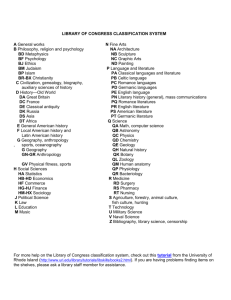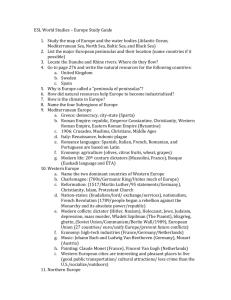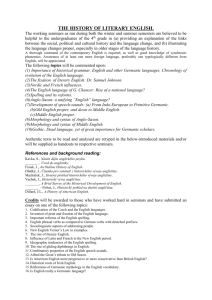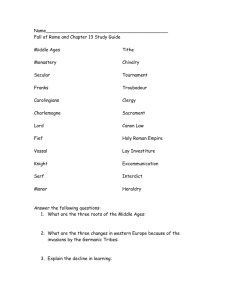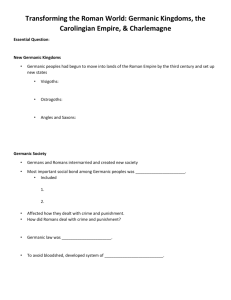pp - University of Southern California
advertisement
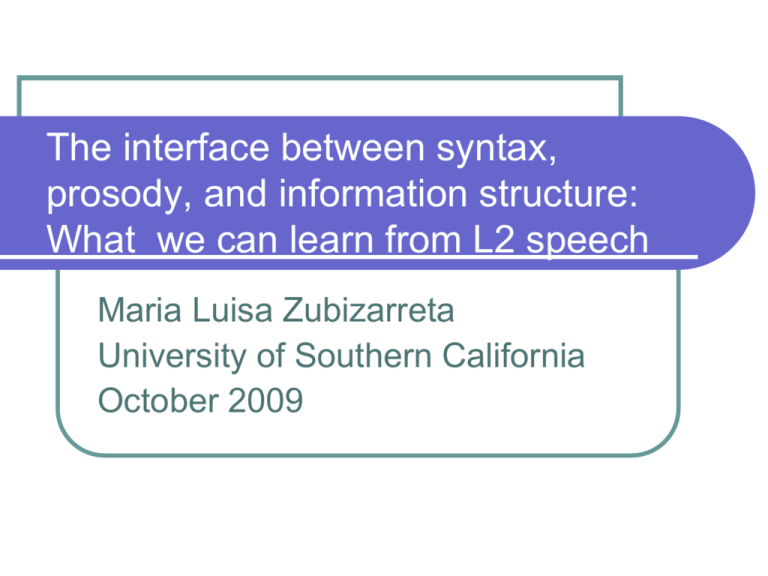
The interface between syntax, prosody, and information structure: What we can learn from L2 speech Maria Luisa Zubizarreta University of Southern California October 2009 The grammatical relevance of discourse-based distinctions. The focus-presupposition divide The new-given information divide Grammatically encoded in terms of a quantificational structure Grammatically encoded in terms of anaphora The topic-comment divide; e.g. categorical vs. thetic statements Grammatically encoded in terms of predication. Grammatical identification of focus Scope of focus identified via: Nuclear Stress --rhythmically most prominent word in sentence --e.g. Germanic and Romance. Prosodic phrasing --e.g. Bengali (Hayes & Lahiri 1991), Korean (Jun 1993), Chitumbuka (Downing 2006) , French (Féry 2001). Morpho-syntax: syntactic position and morpho-syntactic markers (e.g. Chinese, WestAfrican languages). Combination of above mechanisms. Nuclear Stress and Focus. The focused constituent must contain the word with NS (Chomsky 1971, Jackendoff 1972). NSR generates unmarked patterns, i.e. patterns compatible with wide focus. Q: What’s new? A: John broke his leg. vs. *John broke his leg Marked prominence patterns: deaccenting & NS-Shift patterns. In English (& other lgs), NS aligns with the Nuclear Pitch Accent (NPA): the last PA in the Intonational Phrase In English, given information gets deaccented (PA deletion or reduction) If deacc constituent is contained within the focus, NS-Shift applies: Words with no PA are less prominent than words with PA (in English) “Given” within the assertion “Givenness”: explicit mention. Q1: Why are you buying that old stamp? A1: Because I [foc collect stamps]. “Givenness” inferred from context (Ladd 1980,1996) Q2: Why didn’t you read the article I gave you? A2: I [foc can’t read German] Non-asserted “Given”: Narrow focus cases Wide focus: Q1: What’s new? A1: [John broke his leg]. Narrow focus: Q2 :Who broke his leg? A2: [foc John ] broke his leg. (VP deacc) Domain of Nuclear Stress. A Caveat Nuclear Pitch Accent aligns with NS. In core cases, domain of NS is the sentence (= Intonational Phrase or InP) Symmetry “Sentence = InP” can be distorted by phonological weight and length, giving rise to “rephrasing” & “restructuring” of NS domain. Core cases: primary linguistic data for acquisition. Determining Nuclear Stress. Different Views. Syntactic approaches: NSR applies directly to the syntactic structure: Chomsky & Halle 1968, Cinque 1993, Kahnemuyipour 2004 NSR applies to a “metrically interpreted” syntactic structure: Halle & Vergnaud 1984, Zubizarreta 1998, Zubizarreta & Vergnaud 2003, Nava & Zubizarreta 2009, to appear. Determining Nuclear Stress. Different Views. The prosodic phrasing approach (Selkirk 1986, Nespor & Vogel 1986): Phonological phrase derived from syntactic structure via mapping algorithms Phrasal stress assigned to (right or left) edge of phonological phrase. NS identified as the stress on the last phonological phrase. Nuclear Stress: the relevance of syntactic structure Adjunct-argument distinction in Germanic sentences and compounds (1) a. Hans hat an seinem Papier gearbeitet. Hans has on his paper worked b. Hans hat in seinem Büro gearbeitet. Hans has in his office worked (Krifka 1984) (2)a. tree-eater ‘someone who eats trees’ b. tree-eater ‘someone who eats on a tree’ (3)a. toy-factory ‘factory that makes toys’ b. toy-factory ‘a toy that is a factory’ ( Fudge 1984, Selkirk 1984, Giegerich 2004, among others ) Non-Phrase final NS in Germanic Unmarked stress patterns with nonsentence final NS (esp. with unacc verbs) (1) Why are you so happy? My friend arrived. (100%) (2) Why are the kids looking outside? A rabbit appeared. (100%) (3) What was that crashing sound? A window broke. (100%) (Schmerling 1976, Selkirk 1984, 1995, Gussenhoven 1984. Exs from Nava & Zubizarreta’s experimental protocol (in press)). Nuclear Stress: final vs. nonfinal NS in intransitives NS on the subject The pizza arrived. SV S Adv V NS rightmost (Gussenhoven 1984) The pizza quickly arrived. Nuclear Stress: the relevance of semantico-pragmatic factors Germanic Variability (esp. with unegartive verbs) (4) How did the party end? A guest sang. (57%) A guest sang. (43%) Pragmatics (predictability & noteworthiness) (5) Why are those children screaming? Because a dog is barking. (71%) (6) Why does everybody look so surprised? Because a dog is singing. (81%) (Exs. from Nava & Zubizarreta’s in press) Categorical vs. thetic marking via NS Categorical/thetic distinction can be marked via NS in Germanic (Sasse 1987). Unacc (due to their lexical semantics) tend to be construed as thetic (or eventive): SV Unergatives tend to be variable: SV (thetic) or (SV) (categorical) Pragmatics (predictability or noteworthiness) can influence construal of statement as categorical or thetic P-phrasing: categorical vs. thetic No one-to-one correlation between NS placement and p-phrasing (S V) ‘my friend arrived’ (unacc) (S) (V) ‘a guest sang’ (uneg) (S V) ‘a guest sang’ (unerg) Stress retraction: (ANne Marie BYcicled) Cf. Inkelas & Zec 1993 Nuclear Stress: Germanic vs. Romance Germanic: flexible NS sentence-final and non-sentence final NS patterns. variability in the positioning of NS in certain structures (SV intransitives) Romance: rigid NS (e.g. Hualde 2006, 2009, Sosa 1999, Zubizarreta 1998 for Spanish) phrase-final NS patterns no variability Theticity marking: Germanic vs. Romance Categorical / thetic distinction encoded syntactically in Romance, ie. via word in Span VS (thetic) vs. SV (categorical) Theticity can also be expressed syntactically in English (there-construction). Cross-linguistic difference remains (not explainable by discourse-considerations). There’s a dolphin swimming. Hay un delfin nadando. The NSR: our view. A grammatically encapsulated algorithm. Generates “unmarked” rhythmic patterns –compatible with wide focus. In Germanic, NSR generates variable patterns in certain structures. Speaker chooses a particular NS pattern depending on: Sentence thetic or categorical; information highlighting Cross-linguistic differences: Prosody of function words categories Prosodic nature of function words at the heart of the Romance/Germanic NSR parameter. Germanic: function words may be unstressed/reduced functional categories may be metrically invisible. Spanish: function words not reduced functional categories metrically visible. The prosodic status of (semi)-function verbs. Non-lexical verbs are intrinsically unstressed/reduced (Inkelas & Zec 1993) Becomes metrically strong: (Altenberg p. 172-3) If clause final. “Wherever she was, always a letter came through, asking how she was.” If followed by deaccented anaphoric complement. I […] asked him how he was doing it.” If emphatic. “It had to be a well.” A two-layer NSR. NSR applies to a metrically interpreted syntactic tree & assigns Strong vs. Weak to sister nodes (Liberman 1975). Given two metrical sister nodes A and B: (i) If A is a head and B is its argument, assign S(trong) to B. (specific NSR) (ii) Otherwise, assign S(trong) to the rightmost constituent node (general NSR). (Zubizarreta 1998, Zubizarreta & Vergnaud 2003) Germanic NS patterns. A metrical analysis. Nw Tw a dog is Vs barking Ns a dog T is Vw barking Germanic NS patterns. A metrical analysis. Nw (T) Advw Vs The pizza quickly arrived Germanic NS patterns Nw Aspw Vs I saw a dolphin swimming NS Asp Vw I saw a dolphin swimming Germanic NS: Compositional Compounds NS mice NW hunt-ing ‘the hunting of mice’ NW night NS hunt-ing ‘hunting at night’ Anaphoric Deaccenting A-deaccenting: pitch-range reduction interacts directly with discourse not gramm constraint variable & gradient Output of A-deacc (as well as Emphasis) affects metrical structure NS-Shift. non-pitch accented syllables always metrically weaker than pitch-accented ones Model of Grammar (preliminary) proposal segmental phonology core syntax p-syntax LF (NSR & other rhythmic rules, p-phrasing, PA assignment) discourse Intonational Phonetics (A- deacc, emphasis, etc) Recapitulation 2 distinct types of phenomena: Type 1: Phenomena to be described at an abstract grammatically-encapsulated level (e.g. NSR) Type 2: Phenomena to be described at the interface level between signal & discourse (e.g. A-deaccenting, Emphasis) A-deacc: English vs. Spanish Spanish does not use A-deacc No grammatical reason Rather, stylistic reasons. Spanish uses other grammatical resources instead, such as cliticization and dislocation. Implications. Typological differences: Type 1: deeply rooted in the grammar of the language (e.g. type of NSR depends on the metrical status of functional categories) Type 2: merely stylistic; it has no grammatical “raison d’être”. Hypothesis: Type 2 is more amenable to change than Type 1. L2 Speech: ideal testing grounds L1 Spanish/L2 English speech ideal testing grounds (Nava & Zubizarreta 2009, 2010; Zubizarreta & Nava to appear) L1 & L2: Grammars in competition (Yang 2003) Dominant L2 (L2 “acquired”) Dominant L1 or oscillation between L1 and L2 grammar (L2 “not acquired”) Our L2 study Production of target-like Germanic NS (as a measure of acquisition of Germanic NSR) Production of vowel reduction (as a measure of metrical invisibility) A-deaccenting & NS-shift in wide focus and narrow focused contexts. Studies on L2 rhythm Studies on L2 rhythm: e.g. Carter 2005, White & Mattys 2007, Carter 2005, Gut 2003 Gut 2003 investigated L1 rhythmic influence on vowel duration across populations. Compared L1 Romance (French, Italian, Romanian) and L1 English learners of L2 German. English: general vowel reduction in unstressed syllables. German: vowel reduction in inflectional morphemes & in syllables in final position in lexical words Romance: no vowel reduction. Gut 2003: L2 vowel duration Gut’s results: L1 Romance native populations showed evidence of L1 transfer via their low level of vowel reduction in L2 German. L1 English natives reduced vowels in more contexts in German than German natives. Acquisition of Germanic NS Acquisition of Germanic NS patterns involves two aspects: the formal and the functional acquisition of metrical invisibility of functional categories (i.e.Tense) measured by production of reduced Aux Acquisition of NS as marker of theticity measured by distinction between unacc. (thetic) and unergatives (variable). Timing of acquisition of Germanic NS & Aux-reduction Acquisition of metrical invisibility of Aux is a necessary (although not sufficient) condition for acquisition of Germanic NSR. Prediction: acquisition of Auxreduction should precede acquisition of Germanic NS. Timing of acquisition of Germanic NS vs. A-deaccenting Acquisition of Germanic NS requires “restructuring” of deep-rooted L1 grammatical properties Acquisition of A-deacc requires a stylistic change (no grammatical restructuring involved) Prediction: Acquisition of A-deacc should precede acquisition of Germanic NS. Participants Participants: 34 English Native Controls (ENCs) 46 Spanish L1/English L2 speakers Proficiency determined with Cloze test: Question & Answer (Q&A) Protocol. Scripted dialogue between experimenter and participant. Experimental test items: wide variety of structures in different information structure contexts Latin-square design, with two Q&A sets Dialogue recorded & analyzed with PitchWorks by two independent coders. Coding Coded for presence/absence of pitch accents and position of Nuclear Pitch Accent (i.e. last pitch-accented word) 22 auxiliaries were identified within experimental test items & coded for presence or absence of vowel reduction (contracted Aux and Aux with stressless, reduced vowel) Test items: part 1. 12 SV unaccusatives come (twice), enter, arrive (twice), appear, escape, vanish, broke, close, open, die. 12 SV unergatives bark, roar, swim (twice), talk, dance, sing (twice), smile, run, cry, sneeze. 4 OV compounds Each Q&A set: 6 SV unaccusatives, 6 SV unergatives, and 2 OV-compounds. Results for Cloze-based proficiency groups. Effect of L1 (esp. for intermediates) High Prof: effect of L1 stronger for SV unacc than for compounds. Unacc Sv OV-compound ENC 97% (0.1) 96% (0.1) L2 High 36% (0.2) 71% (0.4) L2 Interm. 4% (0.0) Unergative SV 8% (0.0) Unergative SV ENC 42% (0.3) 58% (0.3) L2 High 39% (0.3) 61% (0.4) L2 Interm. 16% (0.0) 84% (0.2) Results for Cloze-based proficiency groups. Pair-wise group comparison for Germanic NS. All comparisons are significant (<.05) Unacc. SV OVcompound Unergative SV ENC vs. L2 High χ2 = 124.84 (p <.001) χ2 = 15.84 (p <.001) χ2 = 4.72 (p = .030) ENC vs. L2 Interm. χ2 = 214.77 (p <.001) χ2 = 78.93 (p <.001) χ2 = 38.87 (p <.001) L2 High vs. L2 Interm. χ2 = 32.22 (p <.001) χ2 = 33.63 (p <.001) χ2 = 18.20 (p <.001) Results for prosodic-based proficiency groups. L2ers regrouped in terms of above-chance target-production of Germanic NS in unacc SV and OV-compounds (at least 5 out of 8) 9 L2ers above chance level of Germanic NS (+NS group) 37 L2ers at chance, below chance, or no Germanic NS (-NS group) All L2ers in +NS group tested native-like in cloze test (70%-75%). Auxiliary Reduction All +NS L2ers above 75% of Aux-reduction. Great variability in the –NS group. Mean percentage Range ENC 98% 96-100% +NS 93% 78-100% -NS 69% 33-100% Germanic NS & Aux-reduction. Individual Analysis. The function of Germanic NS. Unacc. vs. Unergatives. Results. ENC and +NS L2ers: significantly more SV than SV for unacc, but not for unergatives. Unergative Unergative Unacc. Unacc. SV SV SV SV ENC 42% 58% 97% 3% + NS L2 58% 42% 65% 35% ENC +NS L2er Unergative: SV vs. SV χ2 = 1.088 (p = .297) χ2 = 1.74 (p = .186) Unacc: SV vs. SV χ2 = 107.28 (p < .001) χ2 = 36.99 (p < .001) Summary & conclusion. All +NS L2ers produced more than 75% of Aux Red, but also significant number of –NS L2ers have 75% or more of Aux Red. Acquisition of Aux Red precedes “acquisition” of Germanic NS. +NS L2ers produce signif. more SV than SV patterns with unacc. than with unergatives. +NS L2ers have acquired the function of Germanic NS (as marker of theticity). English: Anaphoric-deaccenting & NS-shift (wide focus contexts) In English (but not in Spanish), “givenness” can trigger significant pitch-reduction at the grammardiscourse interface. If deaccented material includes NS-bearing word, NSShift applies (shifting NS onto metrical sister) Why are you buying that old stamp? Because I collect stamps. (75%) Why are these notebooks missing their covers? Because I’m drawing pictures on the covers. (88%) Anaphoric-deaccenting & NS-shift (wide focus) Q&A protocol contained 4 transitives with “given” DO 4 ditransitives with “given” PP Above chance-level production of Aanaphoric deacc & NS-shift: 16 (out of 27) High Prof. learners 3 Intermediates Recall: only 9 High Prof. learners produced unmarked Germanic NS. English: Anaphoric-deaccenting & NS-Shift (narrow focus). Aligning NS with narrow focus via Adeaccenting & NS-Shift: Who was crying? An actress was crying. Who arrived? My friend arrived. Who broke his leg? A boy broke his leg. Anaphoric-deaccenting & NS-Shift (narrow focus). L1 Spanish-L2 English (Nava & Zubizarreta’s study) Based on 4 SV intran (2 unacc and 2 unergatives) L2ers remarkably accurate. High Prof. are native-like. ENC vs. Interm stats signif. (at p<.05 value) ENC SV 98% Advanced L2 Interm L2 96% 68% Summary & Conclusion. A-deacc is acquired earlier than Germanic NSR (i.e. easier to acquire) Lers switch to A-deacc especially early when it is required for focus-identification Results support our expectations regarding ordering of acquisition. Anecdotal evidence: English influence on deacc patterns in Eng-Span bilinguals. Germanic NS in compounds vs. sentences. Future research. Germanic NS at the phrasal level. Requires acquisition of metrical invisibility of functional categories Germanic NS in compounds. Metrical invisibility of functional categories irrelevant. Expectation: Acquisition of Germanic NS in compounds precedes acquisition of Germanic NS in phrases. Germanic NS in compounds vs. sentences. Future research. Germanic NS should be acquired earlier in compounds than in sentences. No correlation between Aux reduction & Germanic NS in compounds. Prosodic patterns in compounds serve as cue for acquisition of the formal part of Germanic NS; i.e. trigger switch from L1 to L2 algorithm Appendix. Vowel reduction: content vs. function words. “North Wind and the Sun text” (English & Spanish version) Nava et al. 2009: Extracted & measured vowels using a “forced alignment” technique from ASR Compared vowels in content and function words in English across 4 groups: ENCs, L2 +NS, L2 –NS, and Span natives. Vowel reduction: function vs. content words. 2-way ANOVA: sig. diff. (<.05) between 2 types of vowels for ENC and L2 +NS. 140 120 100 80 Function Content 60 40 20 0 ENC L2 +NS L2 -NS SPAN References Altenberg, B. 1987. Prosodic Patterns in Spoken English. Lund University Press. Cruttenden, A. 1997. Intonation, Cambridge University Press. Chomsky, N. & M. Halle. 1968. Sound Patterns of English. New York: Harper & Row. Chomsky, N. 1971. Deep structure, surface structure, and semantic interpretation. In D. Steinberg and L. Jakobovits, eds. Semantics: An interdisciplinary reader in philosophy, linguistics, and psychology. Cambridge: Cambridge University Press. Giegerich, H.J. 2004. Compound or phrase? English noun-plus-noun constructions and the stress criterion. English Language and Linguistics 8:1-24. Gussenhoven, C. 1984. On the grammar and semantics of sentence accents. Dordrecht, Foris. Gut, U. 2003. Prosody in second language speech production: the role of the native language. Fremdsprachen Lehren und Lernen 32, 133-152. References. Huald, J.I. 2006. Stress removal and stress addition in Spanish, Journal of Portuguese Linguistics 5(2), 59-89. Hualde, J.I. 2009. Unstressed Words in Spanish. Language Sciences. 31:199-212. Inkelas, S. and D. Zec. Auxiliary reduction without empty categories: a prosodic account. Working Papers of a the Cornell Phonetics Laboratory. Vol 8: 205-253. Jackendoff, R. 1972. Semantic Interpretation in Generative Grammar. Cambridge, Mass: MIT Press. Jun, S. 1993. The Phonetics and Phonology of Korean Prosody. Ph D. thesis, Ohio State University. Ladd. R. 1980. The structure of Intonational Meaning. Bloomington: Indiana University Press. Ladd, R. 1996. Intonational Phonology. Cambridge University Press, Bloomington. Ladd. R. 1980. The structure of Intonational Meaning. Bloomington: Indiana University Press. References. Ladd, R. 1996. Intonational Phonology. Cambridge University Press, Bloomington. Nava, E. & Zubizarreta, 2009. Order of L2 Acquisition of Prosodic Prominence Patterns: Evidence from L1Spanish/L2 English Speech. In Proceedings of Galana 3. Somerville, Ma: Cascadilla Press. Nava, E. and ML. Zubizarreta. 2010. Deconstructing the Nuclear Stress Algorithm: Evidence from Second Language Speech. In N. Erteschik-Shir & L. Rochman, eds, The Sound Patterns of Syntax, Oxford University Press Pierrehumbert, J. 1980. The phonology and phonetics of English Intonation. PhD doctoral dissertation, Department of Linguistics, MIT, Cambridge, Ma. Sasse, H.J. 1987. The thetic-categorical distinction revisited. Linguistics 25, 511-580. References. Selkirk, E. 1984. Phonology and Syntax: The relation between sound and Structure, MIT Press. Selkirk, E. 1995. Sentence prosody: Intonation, stress, and phrasing. In J. Goldsmith., ed. The handbook of phonological theory. Oxford: Blackwell. Sosa, J.M. 1999. La entoncaion del español. Madrid: Cátedra Zubizarreta, ML and JR. Vergnaud. 2005. Phrasal Stress, Focus, and Syntax. In M.Everaert and H. van Riemsdijk, eds., The Syntax Companion. Cambridge: Blackwell. Zubizarreta, ML. 1998. Focus, Prosody, and Word Order, Cambridge: MIT Press Acknowledgements NSF Grant BCS-0444088 (2005-2009). USC Provost Fellowship for Advancing Scholarship in the Humanities & Social Sciences (2008-2009). USC Undergraduate Research Associates grant (2005-2009).

